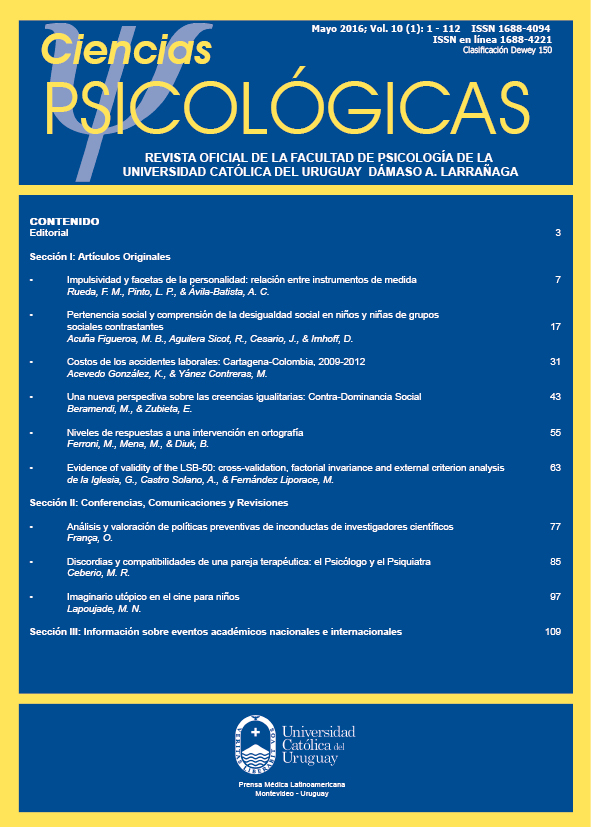IMPULSIVITY AND PERSONALITY FACETS: RELATIONSHIP BETWEEN MEASURING INSTRUMENTS
DOI:
https://doi.org/10.22235/cp.v10i2.1149Keywords:
psychological assessment, impulsivity, personality, five factor model, psychometric, evidence of validityAbstract
The aim was to relate the personality traits with the impulsivity, studying evidence of convergent-discriminant validity for Bateria Fatorial de Personalidade (BFP) and Escala de Avaliação da Impulsividade (EsAvI). Participated 178 soldiers of the Military Police of Minas Gerais, Brazil. In the results, it was used the regression analysis by stepwise method, whereby predictors models were identified, which were composed of facets of the five personality factors, highlighting the factors ‘Emotional Instability’ and ‘Responsibility and Extraversion’ as the most related to impulsivity. It was also observed for factor Lack of Concentration and persistence ‘of ESAVI was revealed models with higher variance explained by a set of facets of BFP.Downloads
References
Barratt, E. S. (1959). Anxiety and Impulsiveness related to psychomotor efficiency. Perceptual and Motor Skills, 9, 191-198.
Barratt, E. S. (1993). Impulsivity: Integrating cognitive, behavioral, biological, and enviromental data. Em W. G., McCown, J. L. Johnson & M. B. Shure. The impulsive Client, 39-53. Washington, DC: American Psychological Association.
Barratt, E., Patton, J., Olsson, N., & Zucker, G. (1981). Impulsivity and paced tapping. Journal of Motor Behavior, 13, 286-300.
Barratt, E.S. & White, R. (1963). Impulsiveness and anxiety related to medical student’s performance and attitudes. Journal of Medical Education, 44, 604-607.
Costa, P.T. & McCrae, R. R. (1995). Domains and Facets: Hierarchical Personality Assessment Using the Revised NEO Personality Inventory. Journal of Personality Assessment, 64(1), 21-50.
Evenden, J. L. (1999). Varieties of impulsivity. Psychopharmacology, 146, 348-361.
Eysenck, S. B. G. & Eysenck, H. J. (1977). The place of impulsiveness in a dimensional system of personality description. British Journal of Social and Clinical Psychology, 16, 57-68.
McCrae, R. R. & Costa, P. T. Jr (1990). Personality in adulthood. New York: Guilford.
Miller, E. (2003). The Measurement of Impulsivity. (Tesis doctoral). Coventry University, School of Health and Social Sciences and University of Warwick.
Moeller, F. G., Barratt, E. S., Dougherty, D. M., Schimitz, J. M., & Swann, A. C. (2001). Psychiatric Aspects of Impulsivity. American Journal of Psychiatry, 158 (11), 1783-1793.
Nunes, C. H. S. S., Hutz, C. S. & Nunes, M. F. O. (2010). Bateria Fatorial de Personalidade (BFP). São Paulo: Casa do Psicólogo.
Patton, J. H., Stanford, M. S., & Barratt, E. S. (1995). Factor Structure of the Barratt Impulsiveness Scale. Journal of Clinical Psychology, 51, 768-784.
Pueyo, A. A. (2003). Evaluación de la impulsividad y riesgo en el uso de armas de fuego en policías y fuerzas de seguridad. Recuperado em 05 de março de 2011 de http://www.raco.cat/index.php/RCSP/article/view/130953/180719
Rueda, F. M. J. & Ávila-Batista, A. C. (2012). Escala de Avaliação da Impulsividade – EsAvI – Formas A e B. São Paulo: Vetor Editora Psicopedagógica Ltda.
Schreiber, L. R. N; Grant, J. E., & Odlaug, B. L. (2012). Emotion regulation and impulsivity in young adults. Journal of Psychiatric Research. 46, 651-658.
doi: 10.1016/j.psychires.2012.02.005
Stanford, M. S., Mathias, C. W., Dougherty, D. M., Lake, S. L., Anderson, N. E., & Patton, J. H. (2009). Fifty years of the Barratt Impulsiveness Scale: An update and review. Personality and Individual Differences, 47, 385-395.
Tabachinick, B. G. & Fidell, L. S. (2007). Using multivariate statistics. (5ª Ed.). New York: Pearson Education, Inc.
Velotti, P. & Garofalo, C. (2015). Personality styles in a non-clinical sample: The role of emotion dysregulation and impulsivity. Personality and Individual Differences, 79, 44-49. doi: 10.1016/j.paid.2015.01.046.
Vigil-Colet, A. & Codorniu-Raga, M. J. (2004). Aggression and inhibition deficits, the role of functional and dysfunctional impulsivity. Personality and Individual Differences, 37, 1431–1440.
Whiteside, S. P. & Lynam, D.R. (2001). The Five Factor Model and impulsivity: using a structural model of personality to understand impulsivity. Personality and Individual Difference, 30, 669-689.
















